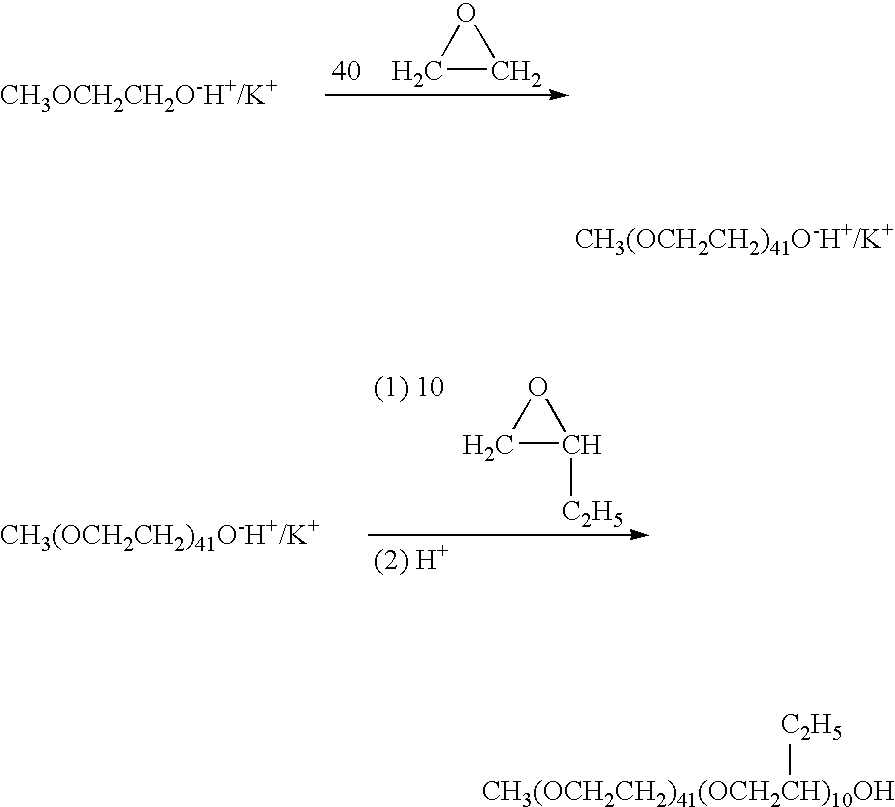Polyalkylene oxide polyquaternary ammonium biocides
a polyalkylene oxide and ammonium biocide technology, applied in the field of biocidal polymers, can solve the problems of high balance, irritation of wearers, damage to mammalian cells,
- Summary
- Abstract
- Description
- Claims
- Application Information
AI Technical Summary
Benefits of technology
Problems solved by technology
Method used
Image
Examples
example 1
[0069]The polymer with formula I-C is suitably obtained by a synthetic method as described below.
[0070]Add thionyl chloride (12 mmol) or phosphorous trichloride (12 mmol) to a round bottom flask fitted with a condenser containing the polymer I-A (12 mmol) in methylene dichloride. (50 ml) and DBU. Reflux the mixture for about 4 hrs (monitor completion of reaction by TLC). Remove excess solvent and thionyl chloride under reduced pressure to obtain dichloride I-B.
[0071]Dissolve 0.2 moles of 1,4-bis-dimethylamino-2-butene in 60 ml water in a round bottom flask fitted with a stirrer and reflux condenser. Add 0.205 moles of dichloride I-B slowly while stirring. Heat the reaction mixture while stirring and maintain the temperature at 60-70° C. for approximately six hours. The reaction progress may be determined by the analysis for the presence of ionic chloride. Evaporate water under vacuum and weigh the residue product I-C.
example 2
[0072]
[0073]Dissolve 0.2 moles of the PEO-PBO-PEO dimethyl amine in 60 ml water in a round bottom flask fitted with a stirrer and reflux condenser. Add 0.205 moles of 1,4-dichloro-2-butene slowly while stirring. Heat the reaction mixture while stirring and maintain the temperature at 60-70° C. for six hours. The reaction time is determined by the analysis for the presence of ionic chloride. Evaporate water under vacuum and weigh the residue.
example 3
Preparation of Structure D
[0074]Poly(1,2-butylene oxide) or Poly(1,2-butylene glycol) (10.4 mmoles) was vacuum dried at 60° C. for 5 hrs. N,N-dimethylacrylamide (28.0 mmoles) was added, tetrahydrofuran (THF) as solvent (20 g) was added. The mixture was stirred under nitrogen. Potassium hydroxide powder (0.05 g) added. The system was stirred at room temperature for 20 hrs. The THF was rotavaporated. Hexane was added to stir. The mixture was transferred to a separation funnel. The mixture in hexane was washed 3 times to obtain the product in hexane. Then hexane was rotavaporated. The raw product was set to vacuum at 50° C. for 10 hrs to obtain product (D).
[0075]Structure D: 1H NMR (CDCl3 solvent, Varian Unity 500 MHz NMR, 8 scans at 5 second delay time). Multi peaks at 0.9 ppm and peaks at 1.44 to 1.46 ppm are for PBO side chain group —CH2—CH3; multi peaks at 2.58 ppm is from PBO—O—CH2—CH2—CON(CH3)2; doublets at 2.9 and 2.99 ppm are from —CON(CH3)2; multi peaks from 3.2 to 3.6 ppm are...
PUM
| Property | Measurement | Unit |
|---|---|---|
| pH | aaaaa | aaaaa |
| pH | aaaaa | aaaaa |
| temperature | aaaaa | aaaaa |
Abstract
Description
Claims
Application Information
 Login to View More
Login to View More - R&D
- Intellectual Property
- Life Sciences
- Materials
- Tech Scout
- Unparalleled Data Quality
- Higher Quality Content
- 60% Fewer Hallucinations
Browse by: Latest US Patents, China's latest patents, Technical Efficacy Thesaurus, Application Domain, Technology Topic, Popular Technical Reports.
© 2025 PatSnap. All rights reserved.Legal|Privacy policy|Modern Slavery Act Transparency Statement|Sitemap|About US| Contact US: help@patsnap.com



